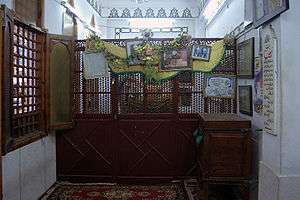Al-Suyuti
Al-Suyuti [6] (c. 1445–1505 CE); aka Jalaluddin; was an Egyptian scholar, historian and jurist. From a family of Persian origin,[7] he was described as one of the most prolific writers of the Middle Ages. His biographical dictionary Bughyat al-wuʻāh fī ṭabaqāt al-lughawīyīn wa-al-nuḥāh contains valuable accounts of prominent figures in the early development of Arabic philology. He was appointed to a chair in the mosque of Baybars in Cairo in 1486, and was an adherent of the Shafii school of thought (madhhab) and a late authority of the Hanbali School. He was one of the Ashabun-Nazzar (Assessors) in his degree of ijtihad.
Jalal al-Din al-Suyuti | |
|---|---|
 Shrine for Galal El-Dean al-Seyoti in Asiut | |
| Personal | |
| Born | 3 October 1445 CE / 1 Rajab 849 AH |
| Died | 18 October 1505 CE / 19 Jumadi Ula 911 AH |
| Religion | Islam |
| Region | Egypt |
| Denomination | Sunni |
| Jurisprudence | Shafi'i[1][2] |
| Creed | Ijtihad[3][4] |
| Main interest(s) | Tafsir, Sharia, Fiqh, Hadith, Quran, Usul al-Fiqh, History, Aqidah |
| Notable work(s) | Tafsir al-Jalalayn Tarikh Al Khulafa Khasais Kubra Khasais Sughra Mazhar Jami al Kabir Jami Al Saghir |
| Tariqa | Shadhili |
| Muslim leader | |
Influenced by
| |
Influenced
| |
| Arabic name | |
| Personal (Ism) | ‘Abd al-Raḥmān |
| Patronymic (Nasab) | ibn Abī Bakr ibn Muḥammad |
| Teknonymic (Kunya) | Abū al-Faḍl |
| Epithet (Laqab) | Jalāl al-Dīn |
| Toponymic (Nisba) | al-Suyūṭī, al-Khuḍayrī, al-Shāfi‘ī |
Biography
Al-Suyuti was born on 3 October 1445 AD (1 Rajab 849 AH) in Cairo, Egypt.[8][9] He hailed from a Persian family on his paternal side. His mother was Circassian.[10] According to al-Suyuti his ancestors came from al-Khudayriyya in Baghdad.[8] His family moved to Asyut in Mamluk Egypt, hence the nisba "Al-Suyuti".[9][11] His father taught Shafi'i law at the Mosque and Khanqah of Shaykhu in Cairo, but died when al-Suyuti was 5 or 6 years old.[11][12]
Al-Suyuti's studies included: Shafi'i and Hanafi jurisprudence (fiqh), traditions (hadith), exegesis (tafsir), theology, history, rhetoric, philosophy, philology,[11] arithmetic, timekeeping (miqat) and medicine. He started teaching Shafi'i jurisprudence at the age of 18, at the same mosque as his father did. In 1486, Sultan Qaitbay appointed him shaykh at the Khanqah of Baybars II, a Sufi lodge.[12] He was a Sufi of the Shadhili order.[9]
Al-Suyuti was named the mujaddid of the 9th century AH and he claimed to be a mujtahid (an authority on source interpretation who gives legal statements on jurisprudence, hadith studies, and Arabic language). This caused friction with scholars and ruling officials, and after a quarrel over the finances of the Sufi lodge, he retreated to the island of Rawda in 1501. Al-Suyuti died on 18 October 1505.[9][12]
Works
The Dalil makhtutat al-Suyuti ("Directory of al-Suyuti's manuscripts") states that al-Suyuti wrote works on over 700 subjects,[11] while a 1995 survey, put the figure between 500[10] and 981. However, these include short pamphlets, and legal opinions.[9]
He wrote his first book, Sharh Al-Isti'aadha wal-Basmalah in 866 AH, at the age of seventeen.
Ibn al-ʿImād writes: "Most of his works become world famous in his lifetime." Renowned as a prolific writer, his student Dawudi said: "I was with the Shaykh Suyuti once, and he wrote three volumes on that day. He could dictate annotations on ĥadīth, and answer my objections at the same time. In his time he was the foremost scholar of the ĥadīth and associated sciences, of the narrators including the uncommon ones, the hadith matn (text), isnad (chain of narrators), the derivation of hadith rulings. He has himself told me, that he had memorized One Hundred Thousand hadith."[13][14]
In Ḥusn al-muḥaḍarah al-Suyuti lists 283 of his works on subjects from religion to medicine. As with Abu'l-Faraj ibn al-Jawzi in his medicinal works, he writes almost exclusively on prophetic medicine, rather than the Islamic-Greek synthesis of medicinal tradition found in the works of Al-Dhahabi. He focuses on diet and natural remedies for serious ailments such as rabies and smallpox, and for simple conditions such as headaches and nosebleeds, and mentions the cosmology behind the principles of medical ethics.[15]
Major works[16]
- Tafsir al-Jalalayn (Arabic: تفسير الجلالين, lit. 'Commentary of the Two Jalals'); a Qur'anic exegesis written by Al-Suyuti and his teacher Jalal al-Din al-Mahalli[11]
- Al-Itqān fi ‘Ulum Al-Qur’an (translated into English as The Perfect Guide to the Sciences of the Qur'an, ISBN 9781859642412)
- Al-Tibb al Nabawi (Arabic: الطب النبوي, lit. 'Prophetic medicine')
- Al-Jaami' al-Kabir (Arabic: الجامع الكبير)
- Al-Jaami' al-Saghir (Arabic: الجامع الصغير, lit. 'Little mosque' )
- Dur al-Manthur (Arabic: درالمنثور) in tafsir
- Alfiyyah al-Hadith [17]
- Tadrib al-Rawi (Arabic: تدريب الراوي) both in hadith terminology
- History of the Caliphs (Tarikh al-khulafa)
- The Khalifas who took the right way, a partial translation of the History of the Caliphs, covering the first four Rashidun caliphs and Hasan ibn Ali
- Tabaqat al-huffaz, an appendix to al-Dhahabi's Tadhkirat al-huffaz
- Nuzhat al-julasāʼ fī ashʻār al-nisāʼ (Arabic: نزهة الجلساء في أشعار النساء), 'an anthology of women's verse'[18]
- Al-Khasais-ul-Kubra, which discusses the miracles of Islamic prophet Muhammad

References
- Barakat, E. R., & HANEEF, M. A. (2006). Must money be limited to only gold and silver?: a survey of Fiqhi opinions and some implications. Journal of King Abdulaziz University: Islamic Economics, 19(1).
- Sookhdeo, Patrick. "Issues of interpreting the Koran and Hadith." Connections 5.3 (2006): 57-82.
- Spevack, Aaron (2014). The Archetypal Sunni Scholar: Law, Theology, and Mysticism in the Synthesis of Al-Bajuri. State University of New York Press. pp. 99, 179. ISBN 143845371X.
- In Masalik al-Hunafa' fi Walidayy al-Mustafa, he says: "The Prophet's parents died before he was sent as a Prophet and there is no punishment for them, since (We never punish until We send a messenger (whom they reject)( (17:15 ). Our Ash`ari Imams among those in kalam, usul, and fiqh agree on the statement that one who dies while da`wa has not reached him, dies saved. This has been defined by Imam al-Shafi`i.. . . Some of the fuqaha' explained that the reason is, such a person follows fitra or Primordial Disposition, and has not stubbornly refused nor rejected any Messenger"
- Ali, Mufti. "Aristotelianisme Dalam Kacamata Para Tokoh Abad Tengah Penentang Logika." Al Qalam 24.3 (2007): 318-339.
- (Arabic: جلال الدين عبد الرحمن بن أبي بكر بن محمد الخضيري السيوطي, Abū al-Faḍl ‘Abd al-Raḥmān ibn Abī Bakr ibn Muḥammad Jalāl al-Dīn al-Khuḍayrī al-Suyūṭī (Brill 2nd)
- Meri, Josef W. (January 2006). Medieval Islamic Civilization, Volume 1 An Encyclopedia. Routledge. p. 784. ISBN 978-0-415-96691-7.
The family of al-Suyuti, of Persian origin, settled during the Mamluk period in Asyut, in Upper Egypt (from where they derive their name).
- Geoffroy, E. (1960–2007). "al-Suyūṭī". In P. Bearman (ed.). Encyclopaedia of Islam (2nd ed.). ISBN 9789004161214.
- Meri, Josef W., ed. (2005). "Suyuti, Al-, 'Abd al-Rahman". Medieval Islamic Civilization: An Encyclopedia. Routledge. pp. 784–786. ISBN 978-1-135-45603-0.
- Irwin, R. (1998). Julie Scott Meisami; Paul Starkey (eds.). Encyclopedia of Arabic Literature. Taylor & Francis. p. 746. ISBN 978-0-415-18572-1.
- Oliver Leaman, ed. (2006). "Al-Suyuti". The Qur'an: An Encyclopedia. Taylor & Francis. pp. 618–920. ISBN 978-0-415-32639-1.
- Dhanani, Alnoor (2007). "Suyūṭī: Abū al‐Faḍl ʿAbd al‐Raḥmān Jalāl al‐Dīn al‐Suyūṭī". In Thomas Hockey (ed.). The Biographical Encyclopedia of Astronomers. New York: Springer. pp. 1112–3. ISBN 978-0-387-31022-0.
- Al-Kawākib as-Sāyirah 1/228
- Hasan, Abu, Imām Jalāluddin Suyūţi - Biography and Works (PDF), www.sunniport.com, pp. 6–7, archived from the original (pdf) on 2016-03-04, retrieved 2016-01-04
- Emilie Savage-Smith, "Medicine." Taken from Encyclopedia of the History of Arabic Science, Volume 3: Technology, Alchemy and Life Sciences, pg. 928. Ed. Roshdi Rasheed. London: Routledge, 1996. ISBN 0415124123
- Ghaffari, Talib (7 January 2011). "Writings of Imam Jalaluddin al-Suyuti". Maktabah Mujaddidiyah. Retrieved 23 November 2013.
- "USC-MSA Compendium of Muslim Texts". Web Archive. 2 January 2008. Archived from the original on 2 January 2008. Retrieved 18 March 2010.
- James Mansfield Nichols, 'The Arabic Verses of Qasmūna bint Ismāʿil ibn Bagdālah', International Journal of Middle East Studies, 13 (1981), 155-58.
External links
| Wikiquote has quotations related to: Al-Suyuti |
| Arabic Wikisource has original text related to this article: |
- Tafsir al-Jalalayn Commentary on the Quran (in English).
- Radiant Cosmography (al Haya al-saniya fi al-haya al-sunniya) in English at archive.org.
- The Dead become Alive by the Grace of the Holy Five (Ihyya al-mayyit) in English at archive.org.
